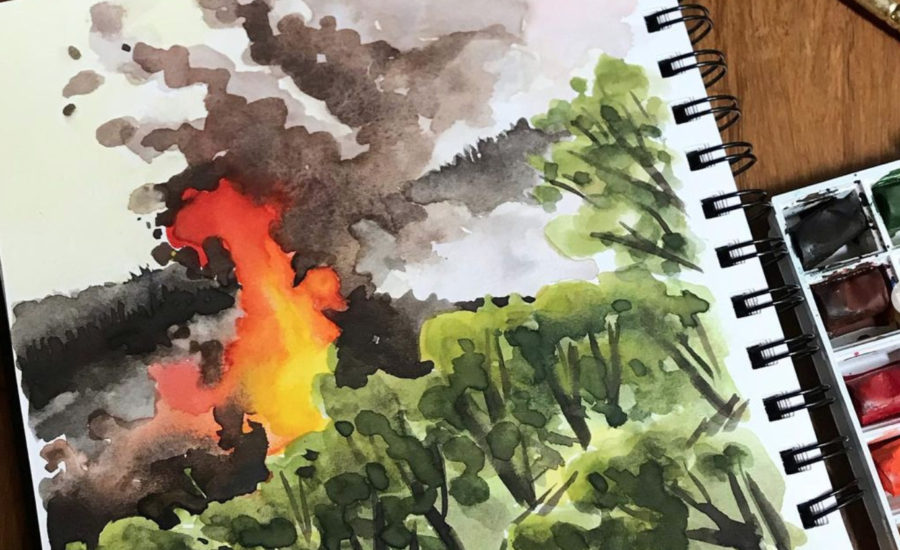Do you have the consistency to go to the same place again and again and observe how it changes? What will you notice as you watch a place change over time? Let Robin Carlson inspire you – she has been nature journaling ecosystem change at Stebbins Cold Canyon, a place that has been twice burned by wildfires in recent years.

A Landscape Affected by Wildfire
In this interview with Marley, Robin Carlson talks about how she began this longterm project of observing and documenting Stebbins Cold Canyon and how this area responds to wildfire. Robin notes that she has always been interested in the time component of life; previously she studied developmental and evolutionary biology. Though she had never experienced wildfire directly before, she wanted to see the rapid changes wildfire causes. She chose to begin visiting Stebbins Cold Canyon at least once a month because it is close to where she lives.
Stebbins Cold Canyon has burned twice in recent years – once in 2015, and again in 2020. At the end of the 5 year gap and just before the second burn, Robin had noticed that things had begun to slow down in terns of ecosystem change, though change never really stops. Robin notes that even “staying the same” requires an active process:
“Things have to work to stay the same.”

What kinds of tools do we use When nature journaling ecosystem change?
In terms of physical tools, Robin’s preferred supplies are her Kuretake brush pen (with permanent black ink) and Pentel brush pen (with permanent grey ink) to use for shadows. She finds them useful for both quick sketches and for building more complex illustrations. Robin has a strong belief that the initial sketch she makes is the most important, because it has the rawest and most complete impressions in them.
In terms of mental tools, it comes down to observation skills, consistency, and – adding those two together – experience.
Robin’s goal was (and still is) to get to know a specific place – to get to know the plants, animals, fungi who grow there on a deeper level. As such, when she began her longterm exploration, her questions were a lot more general:
“What does it look like? What questions does this generate? What am I seeing?”
Her questions became more targeted over time; now she notices which trees might have died or which have been regrowing, and where the regrowth has been happening.

What changes and what stays the same?
Robin has noticed that green regrowth comes up almost immediately after a wildfire. This leads her to believe there must be a LOT more water in the ecosystem than it would appear, even during summer droughts. Perhaps there are water sources hidden in the burls, in the roots, stored in the materials of the plants both above and below ground, and deeper in the soil.
The creek had just enough water in it that it did not burn, and this was readily apparent by the flowers that continued to bloom there. The hummingbirds in particular were quite happy. Speaking of flowers, in other parts of the canyon, Robin noticed a species called “whispering bells”. To Robin’s knowledge, this wildflower had not bloomed in those parts in over 30 years. Perhaps the seeds had lain dormant in the seedbank until the fires activated them, or perhaps it was some other process that led to their resurgence.
An onsite sign and a donation collections jar stayed the same and did not burn away, though the sign needed a new post.
Some trees died and stayed dead, while others resprouted from the most unlikeliest of places. Bees returned.
You might imagine it would get boring to return to the same place again and again – but Robin assures that she has NOT gotten bored nor run out of things to observe. No matter how much change might appear to slow down, it still looks like a new world to her each time she goes.
To learn more about Robin Carlson, please visit her website: https://robinleecarlson.com
To learn about another wildfire nature journaler (one who inspired Robin!), check out Marley’s interview with Miriam Morrill here.
Just getting started with nature journaling?
Need more tips? If so, check out this post. It will walk you through how to nature journal in 10 steps.
Need help choosing nature journaling supplies? Check out Nature Journaling Supplies: What You Need and What You Do Not
